Recent Updates
08/27/2024 12:00 PM
Jeep's new £100k electric flagship set to drive UK growth
08/27/2024 12:00 PM
Used Volkswagen Up GTI 2017-2023 review
08/27/2024 12:00 PM
BYD Seal 06 GT revealed as VW ID 3 GTX rival
08/27/2024 12:00 PM
New Aston Martin Vanquish to be unveiled on 2 September
08/27/2024 12:00 PM
VW ID 3 GTX Performance is 322bhp electric hot hatch for £46k
08/27/2024 12:00 PM
The best hybrid cars of 2024 - PHEVs and regular hybrids rated
08/26/2024 12:00 PM
JLR will reinvent Discovery to take it out of Defender's shadow
08/26/2024 12:00 PM
The magic behind Bentley's unshakable W12 legend
08/25/2024 12:00 PM
Ginetta G56 GTR: Driving Britain's best-kept supercar secret
08/25/2024 12:00 PM
The cheapest electric cars available in the UK
EV, Hybrid, Hydrogen, Solar & more 21st century mobility!
 Hybrids combine the convenience of fossil fuel with the appeal of zero-emissions running. So which do we recommend?
Hybrids combine the convenience of fossil fuel with the appeal of zero-emissions running. So which do we recommend?
The best hybrid cars deftly combine low emissions with low running costs, plus the ability to fill up in mere moments.
Their commercial success has been quite a thing to witness over the past couple of decades. It has created a broad and varied patchwork of models to choose from for private buyers and company car owners alike.
And it’s that varied selection - at the more compact and affordable end of the spectrum - that we’re getting in among here. If you're after bigger and more luxurious electrified models, we rank those on our best hybrid SUVs page.
As zero-emission sales laws tighten over the coming years and we move closer to the total phasing out of combustion-engined new cars across the UK and the EU by 2035, it’s impossible to say how long the hybrid powertrain will remain such a dominant force - but it must already be considered to be on borrowed time.Â
Car makers are now required by law to register an increasing proportion of their total UK sales volume as zero-emission all-electric cars, on a sliding scale from 2024 onwards that’s set to rise to 80% by 2030 and 100% by 2035. And while PHEVs (plug-in hybrid electric vehicles) and HEVs (hybrid electric vehicles) may help customers prepare for the idea of a fully electrified car, they won’t help their makers to avoid hefty fines if they fail to meet those deadlines.
For now, of course, a hybrid powertrain may simply be the right choice for your next car – perhaps because it saves you money at the petrol pump, or helps drive down how much benefit-in-kind (BIK) company car tax you pay, or gives you a car with a low emissions rating and a useful electric range with which to access a low-emissions zone, or to make most of your daily motoring emissions-free. These are our favourites.
1. Mercedes-Benz C300e
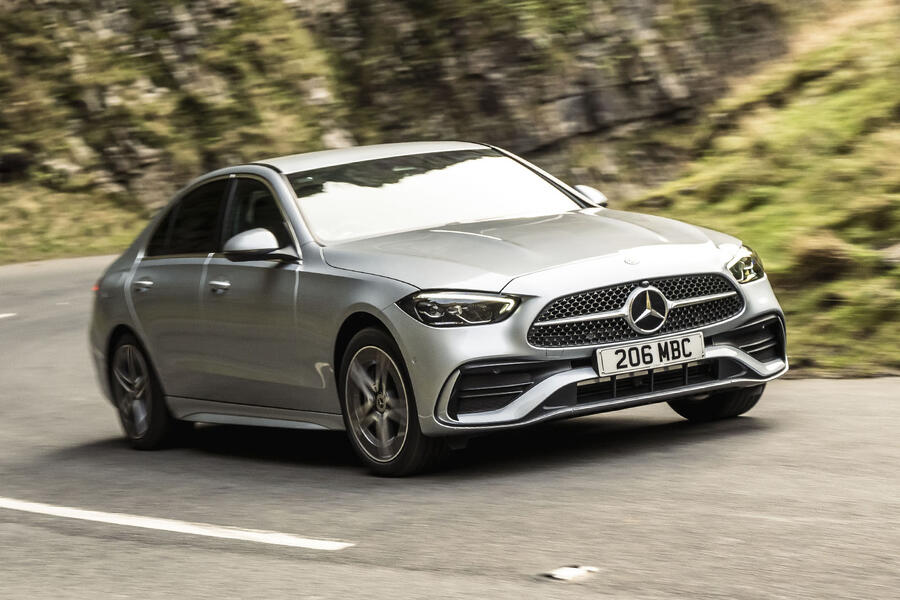
Pros: great electric range for the price, little practicality compromise, lots of digital cabin tech
Cons: doesn't handle like a sports saloon, slightly disappointing cabin quality
Packing a drive battery twice the size of many of its PHEV rivals', the current Mercedes C300e has a claimed WLTP electric range of up to 69 miles. That's enough not only to make the car particularly tax-efficient, but also to make a big difference to the savings it could deliver for drivers who pay for their own fuel.
The C300e's powerplant comprises a 2.0-litre turbocharged petrol engine and a 127bhp electric motor and makes 308bhp in all, in a car that can crack 62mph from rest in just 6.1sec. The model is available in both saloon and estate bodystyles with no significant compromise to either passenger or boot space from its extra PHEV hardware.
The C300e has impressed our road testers with its refinement and isolation, and also with its laid-back, luxury-first, Mercedes S-Class-in-miniature vibes. Keener drivers with less of an eye on their tax bills may probably still prefer to consider the likes of the BMW 330e or Peugeot 508 PSE, but for most fleet drivers and operators, the C300e’s excellent electric range is sure to make it a popular option.
Read our Mercedes-Benz C300e review
2. BMW 2 Series Active Tourer (225e and 230e)
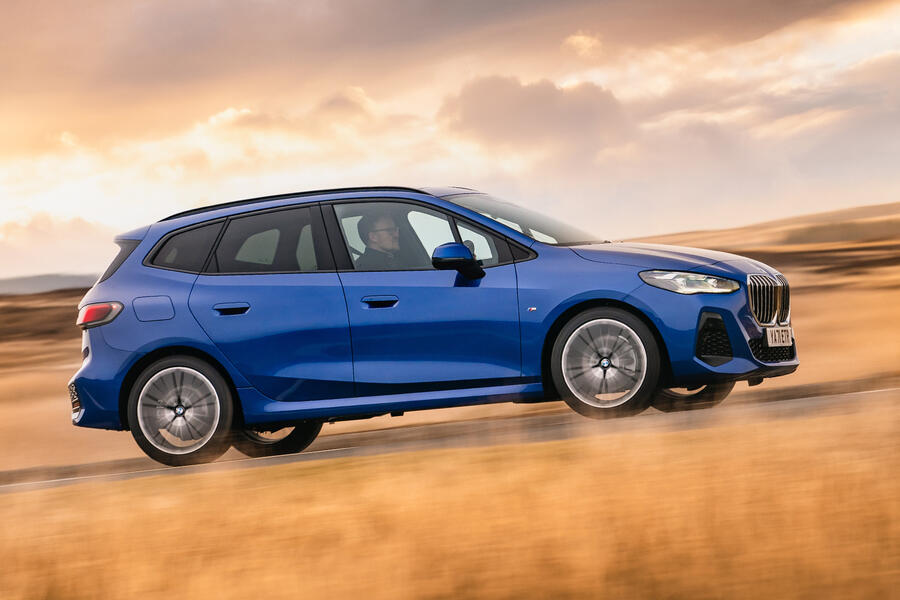
Pros: strong electric range, great packaging and practicality in a compact car
Cons: it’s not the most visually desirable BMW in the showroom, nor the best to drive
The MPV may be all but extinct as an automotive sub-genre, but it appears nobody has told BMW. In fact, in 2023 the brand launched an all-new 2 Series Active Tourer: a car that aims to squeeze people-carrier practicality into the footprint of a compact family car. In a sea of SUV-inspired crossovers, this thoroughly sensible machine is a welcome addition, especially for those who value versatility over the kerbside posturing of pseudo off-roaders.
More importantly, this new-from-the-ground-up model comes with BMW's fifth-generation eDrive electrified technology, which in this case pairs an efficient 108bhp electric motor (mounted on the back axle, so the 225e is effectively four-wheel drive) with a 14.2kWh battery for an impressive claimed EV range of 53 miles - quite a bit more than most compact cars deliver - and a BIK rating of just 8%.Â
Paired with a three-cylinder 1.5-litre petrol, the 225e’s hybrid powertrain delivers a useful 243bhp (there's also a 321bhp 230e) for a decent turn of speed, and while it's not the most thrilling car to drive, the BMW handles accurately with decent grip and body control. Crucially, it rides smoothly and quietly, which is arguably more important for a family machine.
Speaking of which, this may not be the most cleverly packaged MPV, but it gets more space than most traditional hatchbacks, particularly in the back – plus it's packed with handy storage. And it feels a cut above the mainstream, its tight construction and high-grade materials helping to exude class and sophistication.
Read our BMW 2-Series Active Tourer review
3. Toyota Corolla
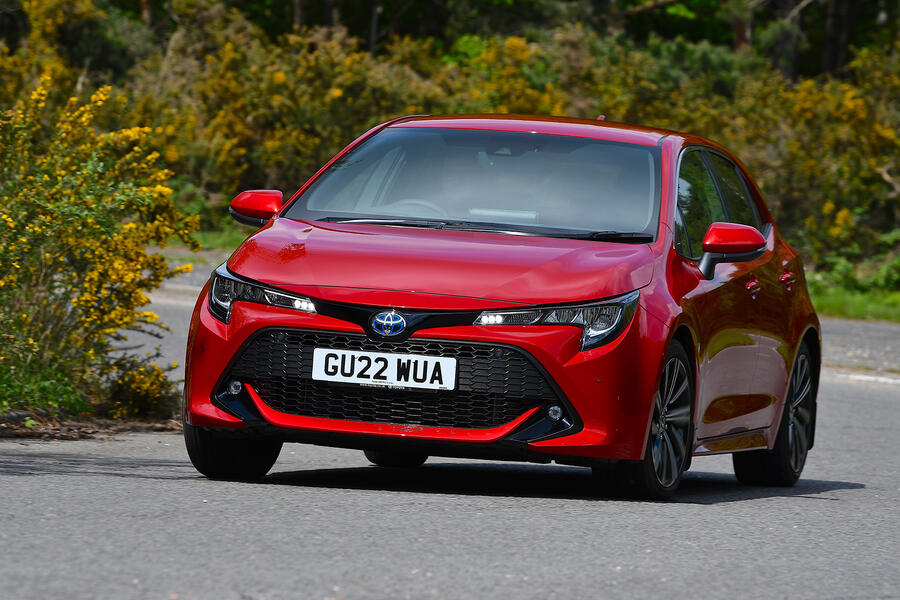
Pros: easy to drive, real-world efficient without any need to plug in, and handles well
Cons: hybrid system has limited performance, and won’t do much to quicken the pulse
Having spent more than two decades introducing the world to the hybrid powertrain, Toyota is now well advanced with normalising it – and no car on sale does this better than the current Corolla.
Ushered in to replace the highly forgettable Auris in 2019, the Corolla was a game-changer for Toyota in what remains one of the most important market segments of them all. It continues to combine a healthy dose of visual style with strong perceived cabin quality and, like one or two other of its showroom siblings introduced over the past few years, is based on a model platform and has been dynamically developed and tuned – quite successfully – for distinguishing ride and handling sophistication.
In its range-topping 2.0-litre hybrid form, it even performs with a bit of sporting edge. The free-spinning, elastic-band-effect acceleration feel of the powertrain can be found if you go looking for it under wide throttle applications, but generally the car's part-throttle responsiveness is much better than you might expect from a traditional Toyota hybrid, and its outright performance level a lot more assured. Alternatively, the more humble 1.8-litre hybrid (which even comes in Corolla Commercial van-like model grade, for those who need it) will routinely return a day-to-day 70mpg, if you drive with one eye on efficiency.
That the Corolla is also one of Toyota's self-proclaimed 'self-charging' hybrids will appeal to people who prefer their motoring lives to be kept simple, and who want a real-world frugal car that they needn’t plug in (either because it’s not practical for them to do so, or they simply can’t). But the all-round ownership credentials of a car that they can feel equally as good about owning and driving as they do about their outgoings at the pump should help keep them satisfied.
Read our Toyota Corolla review
4. Honda Civic
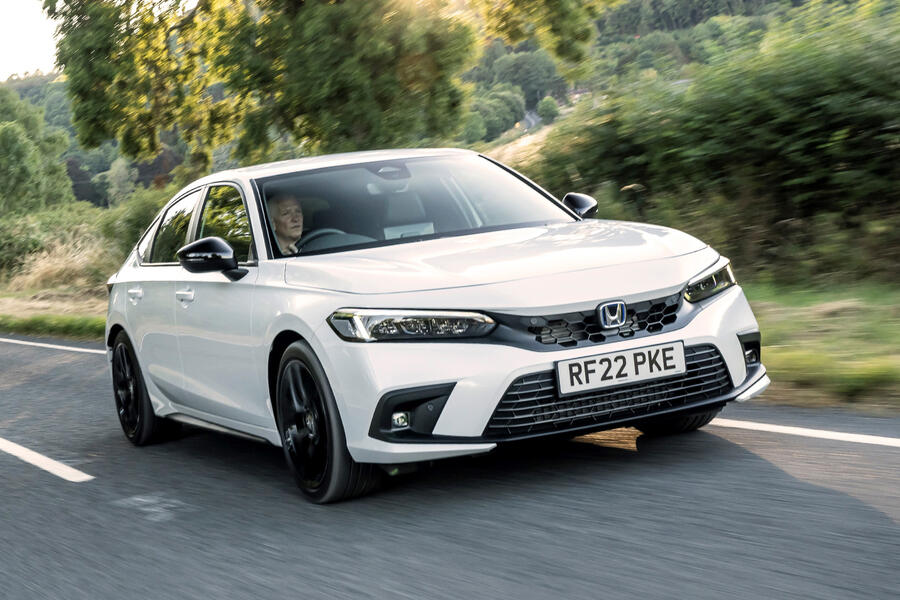
Pros: loads of space in both the cabin and boot, easy to drive efficientlyÂ
Cons: lacks a little kerbside desirability
Like Toyota with its Corolla, Honda has stuck to the traditional family hatchback template for its latest Civic - and it’s all the better for it. Incredibly, the Japanese machine is in its 11th generation, but it shows no signs of slowing down or resting on its laurels. Bigger, more accommodating and easier to live with than ever, this is the super-sensible family hatchback honed to as near perfection as possible.
Ignore the wild Honda Civic Type R fast flagship (tricky when you consider its pugnacious looks) and the Civic is essentially hybrid-only these days. Like the HR-V crossover and Jazz supermini, it uses the brand’s clever e:HEV drivetrain, which in most situations uses the 2.0-litre petrol four-pot as a generator for a 1.05kWh battery that powers a 181bhp electric drive motor. It sounds convoluted, but in partnership with the CVT transmission, it makes for surprisingly swift and smooth progress, while throttle response is keener than you might expect. There’s even a Sport mode that allows the petrol engine to get in on the action more often and adds a pleasingly rorty engine note. Real-world fuel economy won’t quite beat the Toyota Corolla, but it’ll get close, and for those who can’t easily plug in, it’s a sight better than most heavier PHEVs might deliver.
More importantly, the chassis is better still. Here’s a fairly humble hatchback that’s genuinely stimulating to hustle, with quick steering, strong grip and impressive body control that also manifests itself in a composed and comfortable ride. Yet it’s relaxing when you just want to mooch, with low noise levels and easy-going controls that make for hassle-free progress whether you’re slicing through town or pounding along motorways.
Elsewhere, the Honda has all the family car bases covered, with a roomy interior, big boot and more standard kit than you can shake a BMW optional extras brochure at. It even has a user-friendly dashboard that includes physical controls for the most commonly used infotainment and ventilation functions.Â
Read our Honda Civic review
5. Volkswagen Golf eHybrid
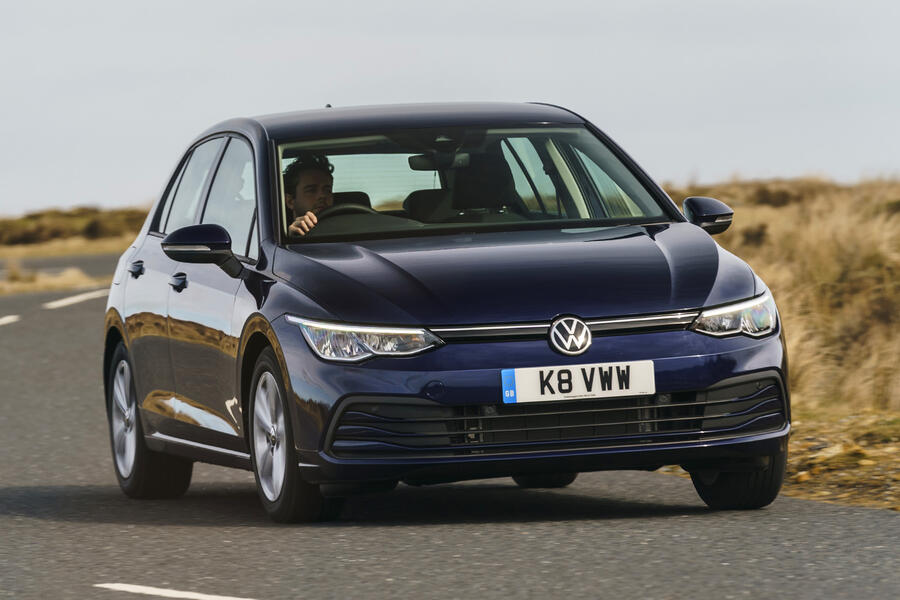
Pros: hits an 8% BIK bracket, has all the usual Golf all-round ownership appeal
Cons: touchscreen infotainment system has some usability issues, cabin quality is not quite what it used to be
Until recently the plug-in Skoda Octavia iV ranked among our favourite affordable hybrid cars, but high demand and supply chain challenges led the Czech firm to temporarily withdraw the car from sale in 2022 - and it has yet to come back. And so, holding up the Volkswagen Group’s honour in the top half of this chart is the VW Golf eHybrid. The Golf uses the same excellent MQB platform chassis and versatile 1.4-litre hybrid powertrain as the Octavia. It’s been around for a while now, with a Golf Mk8.5 facelift imminent, but while the 201bhp power output remains the same, tweaks here and there have boosted the claimed EV range to 43 miles. That figure will be a struggle to match in day-to-day use (35 miles is a more reasonable target), but it does drop the Golf’s BIK burden to just 8%, which is good news for company car drivers. Even better is the fact that it’s a well calibrated set-up: the transition between petrol and electric power is unobtrusive, helped by the smooth dual-clutch transmission.
Elsewhere, this is essentially an eighth-generation Golf, which means it drives well with slick steering, assured handling and a reasonably supple ride. And while it’s not a car that’ll having you grabbing the keys for an illicit late night run (even the 242bhp GTE lacks the cutting edge to make it a true hot hatch), its ability to effortlessly tackle any task is endearing, as is a chameleon-like quality to fit into any surroundings. It’s as comfortable outside Selfridges as it is on the school run – and roomy enough for a family of four too, with plenty of places to dump life’s odds and ends.Â
Niggles? While the interior looks and feels fairly upmarket, cost-cutting means it doesn’t have the rich material finish of its predecessor, and the touchscreen infotainment is a little frustrating to use. Oh, and accommodating the hybrid gubbins reduces the boot capacity to 273 litres.
Read our Volkswagen Golf review
6. Volvo V60 T6 Recharge

Pros: great combination of size, space and versatility, desirability and everyday efficiency
Cons: hybrid system can be a little uncouth when the petrol engine’s running
A little over a decade ago, Volvo was among the pioneers of the plug-in hybrid executive car. Today, it still makes a fairly broad range of them (although its attention has long since turned to fully electric models), and our favourite among the slighter smaller ones is the V60 T6 Recharge.
You can spend rather a lot more money on a modern electrified Volvo than this. But the way this particular V60 combines grounded value for money with real-world efficiency, usable electric range and everyday versatility really does remind you of the very best family cars that the Swedish firm made so many decades ago, before it become preoccupied with sharp-edged modern design.Â
Who in their right mind would claim that 345bhp, and 0-62mph in 5.4sec, isn’t enough for their comfort-first family car, after all? Who would object to ride and handling that pretty squarely aims at the first of those concepts at the expense of the second, but disgraces itself at neither? Who wouldn’t be delighted by a smart, appealing, well-packaged interior full of neat storage solutions, and a 519-litre boot that comes with its own pop-up cargo bay organiser cum elasticated bag holder?
The V60 T6 Recharge seals the deal here with a hybrid system that delivers it 55 miles of lab-verified electric range, and plenty of associated running cost savings potential. So even though it’s one of few £50,000-plus options on this list, it’s a strong contender.
Read our Volvo V60 review
7. Toyota C-HR
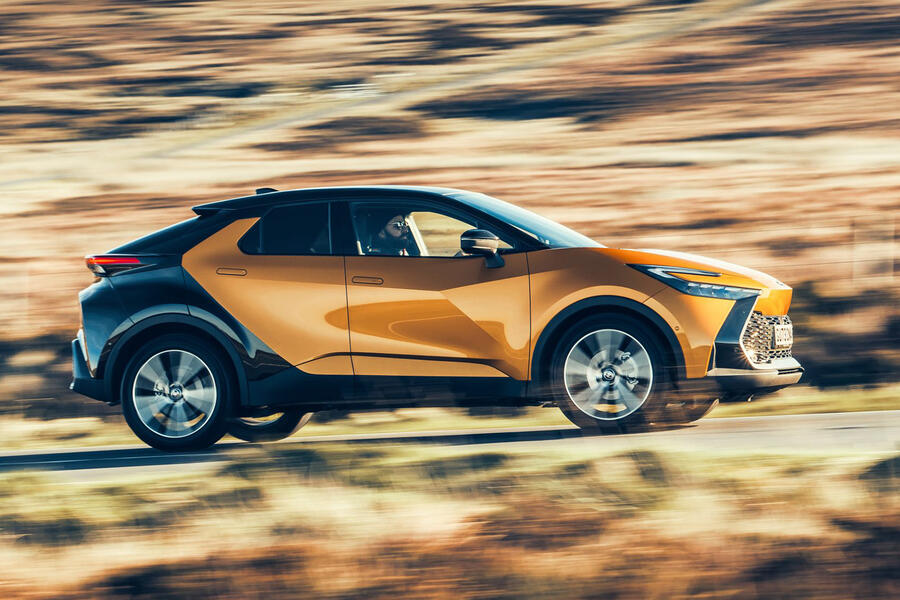
Pros: engaging and refined to drive, impactful styling
Cons: rear cabin and boot aren't the most spacious
If you want evidence of Toyota's expertise in the field of hybrid powertrains, consider the fact that it’s been making petrol-electric machines for the best part of a quarter of a century now. When the original Prius made its debut at the turn of the century, it was seen as something of an oddity, but it turns out it was actually a trendsetter.
Speaking of trends, the C-HR was designed to tap into growing demand for crossovers. Launched in 2016, the eye-catching crossover hatchback did well in its first model generation - and has just been newed in a second-generation form that builds its kerbside appeal to an even finer point, and also broadens its range. So, in addition to 1.8- and 2.0-litre ‘self-charging’ hybrid options, there’s a new 2.0-litre PHEV with a little more power than its range-mates, and just enough electric range to hit an 8% BIK tax bracket.
The C-HR has even more impactful styling in this generation, but its size and its dynamism continue as they were. The car splits the difference between B- an C-segment crossovers (or Ford Puma size and Nissan Qashqai size) and so its rear cabin and boot aren’t huge - but it does carry itself well, and can be both refined and engaging to drive on a decent stretch of road.
The hybrid powertrain at the car’s heart is never the primary source of any enjoyment you’re likely to have at the wheel, but the C-HR offers enough wider appeal to stand out in any case.
Read our Toyota C-HR review
8. Mazda MX-30 R-EV
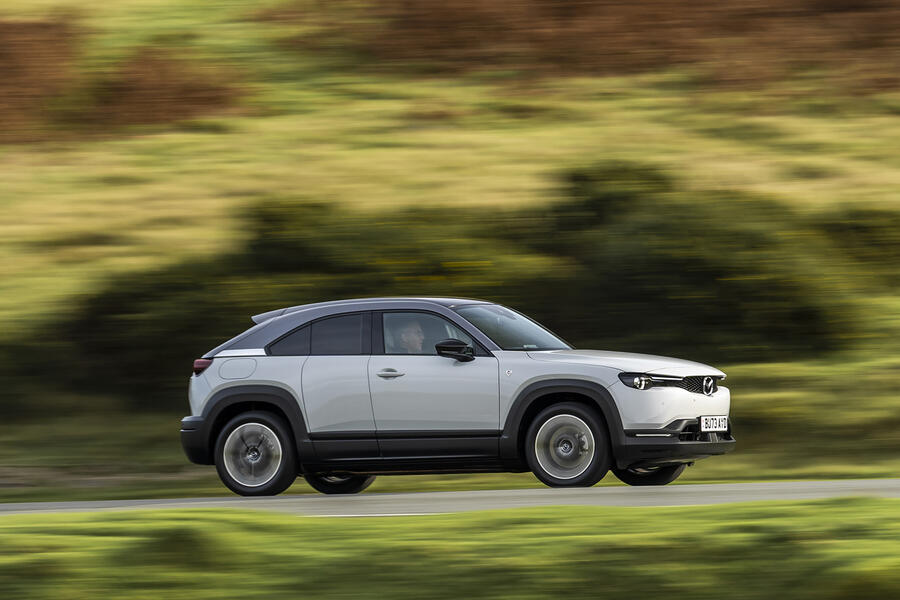
Pros: Upmarket interior, smart styling, sharp steering, quirky mechanical character
Cons: electric-only version might be smarter for short-range hopping and definitely rides and handles better
Mazda has never been afraid to do things its own way, and the approach it took with its first all-electric car - the MX-30 - was no different. How many quirky things have we known Mazda for over the years? Rear-hinged ‘suicide’ side doors? Rotary engines? Well, now that the MX-30 is here in range-extender plug-in hybrid form, it ticks both boxes.
Toy-car looks are, in the all-electric version’s case, wrapped around an unusually small battery pack – just 35.5kWh, giving an official range of 124 miles. If you need more, the R-EV version adds an 830cc rotary engine up front and a 50-litre petrol tank, although it cuts the size of the EV’s drive battery roughly in half. That makes for a combined real-world range of around 400 miles, even if the electric-only range is pegged at 53 miles.
The car is reasonably spacious within, has an SUV-lite body that is very much on trend and is trimmed in interesting materials that give the cabin a singularly cosy and likeable atmosphere.
Dynamically, the MX-30 also stands out - although only when you're travelling with a bit of pace on an interesting road. With 143bhp and 199lb ft, the electric version didn’t blow our socks off in a straight line, but the weighting of the steering and the supple manner in which the suspension transfers weight while cornering are genuinely reminiscent of the MX-5 sports car. The R-EV version is heavier, with less settled body control - but still enjoyable to drive.
There is plenty to like about the unusual Mazda MX-30, then – not least as a rare sub-£35k PHEV that can qualify for 8% BIK tax.
Read our Mazda MX-30 R-EV review
9. Mercedes-Benz CLA 250e
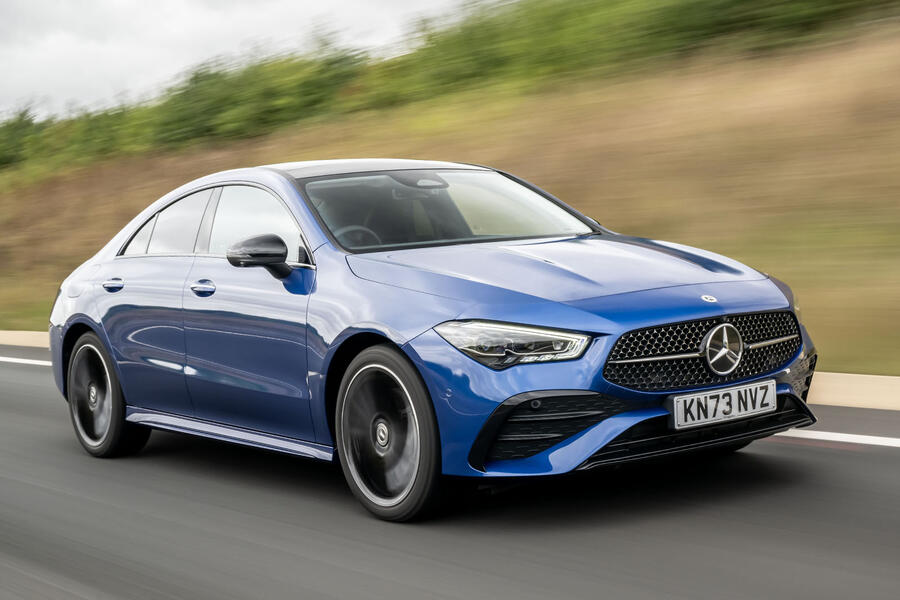
Pros: plenty of design appeal, impressive digital technology, useful electric range
Cons: hybrid powertrain isn’t the smoothest when working hard, can lack traction in the wet
Modern hybrid company cars can be deceptive things. Many come with a headline tax-qualifying electric range attached that can look attractive, but once you dress the car up with the equipment, bodystyle, wheels and trim you want, 5% BIK can turn into 8%, or 8% into 12%.
This is because PHEVs now have to lab-tested right down to a level of detail that takes account of optional extras and trim levels. If you want to be sure of getting a particular tax rate, then, it pays to reckon on a bit of extra breathing space when you look at electric range figures in a brochure or on a car review. And one PHEV that gives you such space is the Mercedes CLA 250e.
This is Mercedes’ compact ‘style saloon’. Sharing its platform with the bigger-selling A-Class, it adds swoopier bodywork and frameless doors for that extra helping of visual allure. And, besides as a four-door coupé, it can also be had as a designer Shooting Brake estate.
The PHEV version is powered by a 1.3-litre turbocharged petrol engine and an electric motor for the front axle, so there’s no electric four-wheel drive here such as the BMW 225e offers. But if you order a bottom-end four-door, it’s rated for 47 miles of electric range; and if you go for an upper-trim AMG Line Premium Plus Shooting Brake instead, it’s rated for 43 miles. Either way, you pay 8% BIK. (The same can’t be said for an equivalent Vauxhall Astra, Seat Leon, Peugeot 508, nor any number of other PHEVs.)
The CLA’s petrol-electric powertrain isn’t the quietest or slickest in operation, but it’s fairly economical and settles to a refined cruise, and the car handles relatively well for a compact premium executive option.
Read our Mercedes-Benz CLA 250e review
10. Peugeot 408 (Hybrid 136 and Hybrid 225)
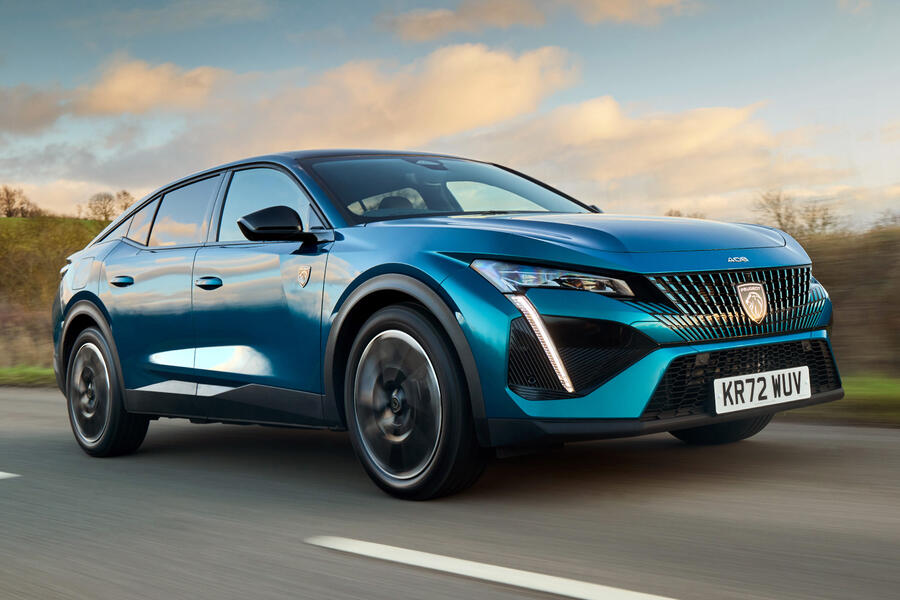
Pros: alternative good looks, plenty of cabin space, appealing to drive, a choice of hybrid powertrains
Cons: PHEV electric range can be marginal
It may be considered a little predictable that French cars don’t rank too highly on this list. Few gallic family car purveyors have invested in either PHEV or HEV powertrain technology with quite enough commitment thus far to lead their competitors - although one or two are now seeing the sense to. However, there are a few tempting, hybrid-powered French alternatives among the market’s various niches - and the Peugeot 408 crossover is certainly one of them.
Sitting somewhere between conventional saloon, estate and SUV bodystyles, this car has an unusual profile - but quite an appealing one. It shares its platform with the smaller 308Â and can be had with a more traditional 1.2-litre turbo petrol engine if you prefer.Â
The pair of petrol-electric options are more interesting, though: there’s a cheaper Hybrid 136 HEV that pairs a three-cylinder turbo engine with a smaller electric motor built into its gearbox, and a pricier and more powerful 1.6-litre PHEV with 221bhp - and a little over 40 miles of electric range, if you get your order just right.
The 408’s longer-travel suspension works well on UK roads; its interior is stylish and fairly roomy; and it certainly cuts a dash in the car park. There’s a boldness to it that shows what good health the Peugeot brand is in, and how much more clearly it understands its role today than it did 20 years ago.Â
The Hybrid 136 is real-world economical without a plug. The Hybrid 225 just about rangy enough to be economical with one.
Read our Peugeot 408 review
